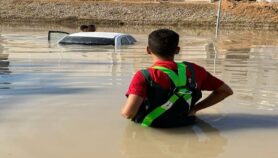By: T.V. Padma
Send to a friend
The details you provide on this page will not be used to send unsolicited email, and will not be sold to a 3rd party. See privacy policy.
[NEW DELHI] India is planning to fly aircraft into the centre of cyclones to gather data to predict where the storm will hit.
This is one of a series of measures to be undertaken by India’s Ministry of Earth Sciences to improve cyclone forecasting. These include increasing and enhancing space-based, land-based and ocean-based observation systems, as well as developing new forecast models.
The aircraft studies start this autumn in the Bay of Bengal as a cyclone-forecasting demonstration project, followed by a pilot phase in 2009–10 and an operational phase by 2011.
The project follows a workshop with the United States on tropical-storm forecasting, held in Delhi at the end of March 2008, where the two countries agreed to work together.
Scientists from the Indian Meteorological Department and other key institutes engaged in weather research will use aircraft reconnaissance to gather information at the cyclone’s ‘eye’ — a calm, cloudless area of 15–40 kilometres radius in the centre, where the pressure is lowest.
Data will also be collected from the surrounding ‘eyewall’, the most destructive part of the cyclone, a 16-kilometre-high belt of the strongest winds, typically exceeding 50 kilometre per hour.
These winds are driven by rapid pressure changes near the eye that dictate the movement of the storm.
In the United States, small helicopters release balloons fitted with sensors to measure wind speed, pressure and direction, and humidity in the eye and the eyewall. These data are fed into forecast models to predict the track, direction and speed of hurricanes — the Atlantic equivalent of cyclones.
But US aircraft may not be available for the Bay of Bengal project in October–November as that is the season for US hurricanes. In this case, Indian Air Force aircraft will be used.
"India currently uses data on winds outside the eye region to estimate the conditions inside and run forecast models," says Dev Raj Sikka, chairman of the scientific advisory committee for the project.
But 48-hour forecasts can only indicate a 250–300-kilometre belt of land where the cyclone is likely to hit. "It is difficult to evacuate such a big area in 48 hours. We need to narrow down to 100 kilometres at least," he says.
Aircraft reconnaissance in the United States over the past 20 years has narrowed prediction of a hurricane’s path from to within 300 kilometres to within 150 kilometres.













